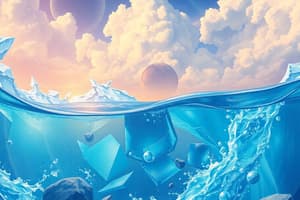Podcast
Questions and Answers
At what temperature is water densest, leading to minimal complete freezing in lakes?
At what temperature is water densest, leading to minimal complete freezing in lakes?
- 4°C (correct)
- 10°C
- 0°C
- 100°C
Which of the following molecules is classified as a compound molecule?
Which of the following molecules is classified as a compound molecule?
- H2
- N2
- O2
- H2O (correct)
What percentage of total water do lakes, rivers, and streams make up?
What percentage of total water do lakes, rivers, and streams make up?
- 0.1%
- 1%
- 0.5%
- 0.01% (correct)
Which statement best explains the relationship between salt balance and water balance?
Which statement best explains the relationship between salt balance and water balance?
What is the boiling point of hydrogen sulfide (H2S)?
What is the boiling point of hydrogen sulfide (H2S)?
What is osmosis?
What is osmosis?
What term describes the mechanisms used by organisms to maintain proper salt balance?
What term describes the mechanisms used by organisms to maintain proper salt balance?
How do freshwater fish maintain their salt balance compared to their environment?
How do freshwater fish maintain their salt balance compared to their environment?
What is the primary nitrogenous byproduct of metabolism in organisms?
What is the primary nitrogenous byproduct of metabolism in organisms?
What is unique about the cichlid species in Lake Victoria?
What is unique about the cichlid species in Lake Victoria?
Flashcards
Density of water at 4°C
Density of water at 4°C
Water is densest at 4°C, causing lakes to not completely freeze (important for aquatic life survival).
Water as a solvent
Water as a solvent
Water dissolves many substances, enabling the transport of nutrients.
Water balance in organisms
Water balance in organisms
Maintaining water levels, crucial for vital functions like photosynthesis, and nutrient transport.
Water's effect on nutrient flow
Water's effect on nutrient flow
Signup and view all the flashcards
Lake turnover
Lake turnover
Signup and view all the flashcards
Osmosis
Osmosis
Signup and view all the flashcards
Osmoregulation
Osmoregulation
Signup and view all the flashcards
Hyperosmotic body fluids
Hyperosmotic body fluids
Signup and view all the flashcards
Hypo-osmotic body fluids
Hypo-osmotic body fluids
Signup and view all the flashcards
Carbon's role in life
Carbon's role in life
Signup and view all the flashcards
Study Notes
Water's Role in Life
- Water comprises a substantial portion of organisms. Human bodies are approximately 72% water.
- Specific organs have varying water content. Lungs, for example, are 90% water, while bones are only 22%.
Properties of Water
- Water's chemical formula is H₂O.
- Water has a molecular weight of 18.
- Water boils at 100°C and freezes at 0°C.
- The equivalent compound, hydrogen sulfide, has different properties and a much lower boiling and freezing point.
Water's States
- Water exists in three states: solid (ice), liquid, and gas (water vapor/steam). Illustrations show the distinct molecular structures of each state.
- The density of water is unique; water is densest at 4°C, which is relevant to many ecological processes, including lake turnover.
Lake Turnover
- Lakes turnover seasonally.
- Water's density at 4°C is crucial for the process of lake layering.
- Turnover results in mixing nutrients and oxygen throughout the lake.
Water as a Solvent
- Water dissolves many substances. It is a universal solvent.
- Various mineral salts, including calcium, magnesium, sodium, potassium, chloride, sulfate, and bicarbonate have differing concentrations in different water samples (e.g., granite, limestone, seawater).
Chemistry Review
- An element is a pure substance, like hydrogen or oxygen (obtained from the periodic table).
- Atoms are the building blocks of matter.
- Molecules form when atoms bond (e.g., O₂ for oxygen gas, H₂O for water).
- A compound molecule has more than one atom bonded, and these atoms are different types (e.g., H₂O, NaCl).
- Ions are charged particles.
- Nutrients are substances needed by living organisms.
- Solutes are substances dissolved in water.
Major Nutrients
- Diverse elements are critical nutrients for life, with varying functions depending on the particular organism. For example, calcium is important for vertebrate animals such as mammals, while it has other functions in trees and other plants.
The Water Cycle
- Water moves through reservoirs like the atmosphere and oceans.
- Processes like precipitation, evaporation, transpiration, and infiltration move water through the environment.
- A small percentage of Earth's water (3.4%) is freshwater.
Water Balance
- Water is vital for photosynthesis and providing a medium for nutrients in organisms.
- Organisms must maintain water balance to survive.
Salt Balance
- Salt balance is closely related to water balance in organisms.
- Loss of water by evaporation increases salt concentration.
- Solute concentration impacts water movement through osmosis.
Osmosis
- Osmosis is the passive movement of water across a membrane, from a region of low solute concentration to a region of high solute concentration.
Osmoregulation
- Organisms use osmoregulation mechanisms to control salt balance.
Water and Salt Balance in Aquatic Organisms
- Different aquatic organisms have different osmotic potentials relative to their surroundings.
- Freshwater fish have body fluids with higher salt content than their environment.
- Marine fish have body fluids with lower salt content than their environment.
Osmoregulation Mechanisms in Aquatic Organisms
- Freshwater fish drink little water, absorb water through skin, and actively import ions (through their gills) and excrete dilute urine.
- Marine fish drink lots of water, lose water through skin, and actively export ions (through gills) and excrete concentrated urine.
- Organisms may have special strategies to maintain salt and water balance, for example, retaining urea.
Other Topics
-
Cichlid Radiation: The cichlids in Lake Victoria are a notable example of adaptive radiation, rapidly evolving diverse species in a relatively short time.
-
Salmon Life Cycle: Salmon demonstrate adaptations for traversing between freshwater and saltwater environments.
-
Carbon: Carbon is a building block of life and is present in all life forms.
-
Obtaining Carbon in Water: Carbon dioxide from the atmosphere dissolves in water and is converted to bicarbonate ions.
-
Eutrophication is the process of nutrient enrichment in water bodies, often resulting in algal blooms and oxygen depletion.
-
Lake Victoria Case Study: A detailed examination of ecological and human impacts on Lake Victoria and its ecosystem.
-
Human Impacts: High human populations, overfishing, eutrophication, introduced species (Nile perch, water hyacinth), and ecosystem alterations have dramatically affected Lake Victoria.
-
Economic and Health Consequences: Decimation of fish populations, spread of diseases such as malaria and schistosomiasis, and other impacts of ecosystem changes have resulted.
-
Basic and Applied Ecology: Factors in Ecosystem Change: Understanding species interactions, biotic requirements (such as sunlight and nutrients), and population changes over time are essential to address significant environmental issues.
Studying That Suits You
Use AI to generate personalized quizzes and flashcards to suit your learning preferences.




